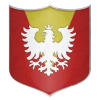Vasca/eraldia: Difference between revisions
| Line 11: | Line 11: | ||
{{Col-begin}} | {{Col-begin}} | ||
{{Col-2}} | {{Col-2}} | ||
=== La Scermo de Bejeta === | === La Scermo de Bejeta === | ||
Revision as of 04:27, 8 September 2016
Vascan heraldry originally followed the tradition of Iberian heraldry, a constituent part of the Latin heraldry family. In the late 14th century, it came under significant influence from English heraldry. Vascan heraldry then evolved, arriving in the 16th century with many specific national features, achieving a peak that was marked by the ordinances of Prinse Alesandro II, which defined strict heraldic rules and established the statutes for the officers of arms.
Heraldry declined in Vasca from the 17th to the 19th century. However, in the late 19th century and especially in the 20th century, it had a strong revival, mainly driven by the high development of the civic, corporate and military heraldry.
La Scermo de Vasca
Arms of Counties
All counties within Vasca have coats of arms; these are often intertwined with local traditions.
La Scermo de BejetaThe county of Bejeta is the western-most county. The county seat and largest city is Raial. The current governor is Contesa Abigela Mendosa. Being home to the second largest inland bay, Bejeta enjoys a healthy sea-trade economy and fishing industry. La Scermo de BragaThe county of Braga is the second smallest county in Vasca. Located on the north-eastern corner of the island, it is bordered by the counties Delenio, and la Feudo de Mosta. The county seat and largest city is Beria. The current governor is Marci Gustavo Adan Zabala. Braga is home to a robust tourist area, but is also where most ground forces of the Vascan military train. La Scermo de DelenioLa Scermo de FranconiaLa Scermo de GorosLa Scermo de Masada |
La Scermo de La feudo de MostaLa Scermo de OrdinoLa Scermo de La RocaLa Scermo de SanatLa Scermo de Verona |











